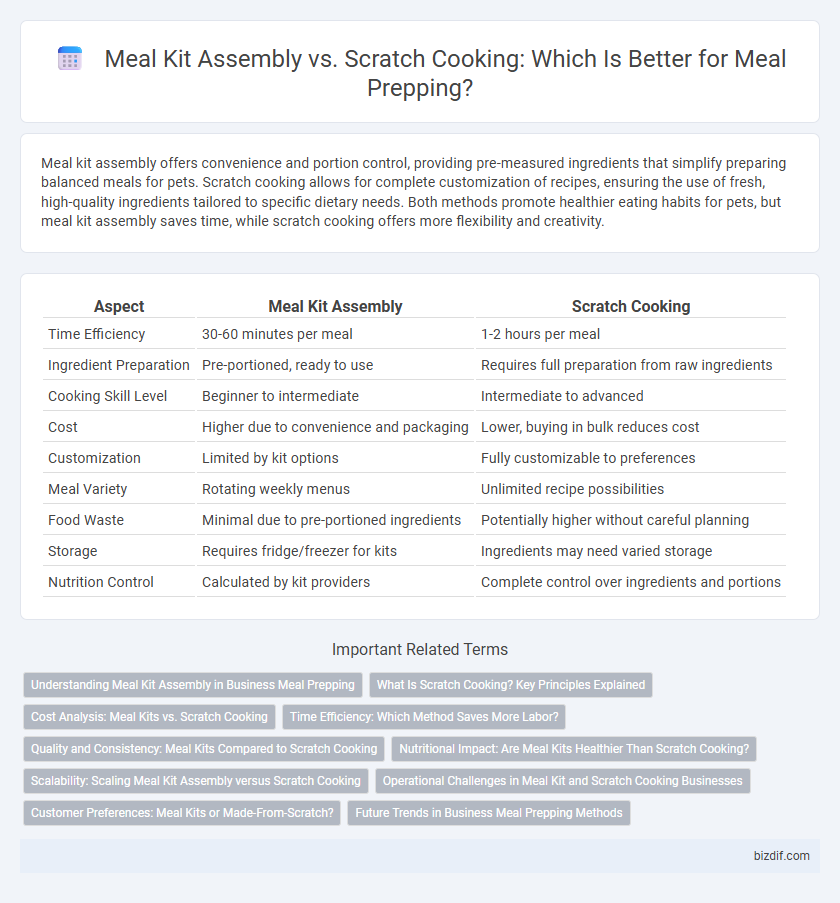Meal kit assembly offers convenience and portion control, providing pre-measured ingredients that simplify preparing balanced meals for pets. Scratch cooking allows for complete customization of recipes, ensuring the use of fresh, high-quality ingredients tailored to specific dietary needs. Both methods promote healthier eating habits for pets, but meal kit assembly saves time, while scratch cooking offers more flexibility and creativity.
Table of Comparison
| Aspect | Meal Kit Assembly | Scratch Cooking |
|---|---|---|
| Time Efficiency | 30-60 minutes per meal | 1-2 hours per meal |
| Ingredient Preparation | Pre-portioned, ready to use | Requires full preparation from raw ingredients |
| Cooking Skill Level | Beginner to intermediate | Intermediate to advanced |
| Cost | Higher due to convenience and packaging | Lower, buying in bulk reduces cost |
| Customization | Limited by kit options | Fully customizable to preferences |
| Meal Variety | Rotating weekly menus | Unlimited recipe possibilities |
| Food Waste | Minimal due to pre-portioned ingredients | Potentially higher without careful planning |
| Storage | Requires fridge/freezer for kits | Ingredients may need varied storage |
| Nutrition Control | Calculated by kit providers | Complete control over ingredients and portions |
Understanding Meal Kit Assembly in Business Meal Prepping
Meal kit assembly in business meal prepping streamlines food preparation by providing pre-portioned ingredients and detailed recipe instructions, reducing labor time and minimizing waste compared to scratch cooking. This method enhances operational efficiency, improves portion control, and ensures consistent taste and quality across meals. Leveraging meal kits supports scalability in food service businesses by simplifying inventory management and enabling faster meal turnaround.
What Is Scratch Cooking? Key Principles Explained
Scratch cooking involves preparing meals entirely from raw ingredients, emphasizing freshness, nutritional control, and customization. Key principles include selecting whole foods, minimizing processed components, and applying fundamental cooking techniques to enhance flavor and texture naturally. This approach fosters culinary skills and allows precise management of dietary needs and ingredient quality.
Cost Analysis: Meal Kits vs. Scratch Cooking
Meal kits often carry a higher upfront cost per serving due to packaging, convenience, and ingredient sourcing, averaging $8 to $12 per meal compared to scratch cooking which can cost $3 to $6 per serving depending on ingredient choices. Scratch cooking allows bulk purchasing and ingredient versatility, significantly reducing per-meal expenses but demands more time and culinary skill. Evaluating cost-effectiveness depends on balancing convenience against budget, where meal kits streamline planning and avoid waste, while scratch cooking maximizes savings through customizable portions and ingredient reuse.
Time Efficiency: Which Method Saves More Labor?
Meal kit assembly significantly reduces labor time by providing pre-portioned ingredients and step-by-step instructions, streamlining the cooking process and minimizing prep work. Scratch cooking demands more time for ingredient gathering, measuring, and preparation, increasing overall labor despite offering greater customization. For busy individuals seeking maximum time efficiency, meal kits offer a faster alternative to traditional scratch cooking.
Quality and Consistency: Meal Kits Compared to Scratch Cooking
Meal kit assembly provides a standardized approach to meal preparation, ensuring consistent portion sizes and ingredient quality with pre-measured components sourced by reputable suppliers. Scratch cooking offers greater flexibility for ingredient selection and customization, allowing for fresh, high-quality produce but requires skill to maintain consistency across meals. The controlled environment of meal kits reduces variability, while scratch cooking's quality depends heavily on individual technique and ingredient choices.
Nutritional Impact: Are Meal Kits Healthier Than Scratch Cooking?
Meal kit assembly offers controlled portion sizes and pre-measured ingredients, which can reduce the risk of overeating and promote balanced nutrition. Scratch cooking allows for greater customization and the use of whole, unprocessed ingredients, potentially leading to higher nutrient density and fewer additives. Nutritional impact varies widely based on meal kit choices and scratch cooking recipes, but scratch cooking generally provides more control over ingredient quality and nutrient retention.
Scalability: Scaling Meal Kit Assembly versus Scratch Cooking
Meal kit assembly offers superior scalability compared to scratch cooking due to standardized processes and pre-portioned ingredients, enabling faster production and consistent quality at larger volumes. Scratch cooking demands more skilled labor and variable cooking times, making it challenging to scale efficiently without compromising taste and safety. Businesses aiming for rapid growth often prefer meal kit assembly to streamline operations and meet increasing consumer demand.
Operational Challenges in Meal Kit and Scratch Cooking Businesses
Meal kit assembly faces operational challenges such as inventory management complexity, supply chain coordination, and consistent quality control to ensure timely delivery and customer satisfaction. Scratch cooking businesses must manage labor-intensive processes, ingredient sourcing variability, and higher risks of waste, which impact scalability and cost-efficiency. Both models require robust demand forecasting and efficient workflow design to minimize operational bottlenecks and optimize profit margins.
Customer Preferences: Meal Kits or Made-From-Scratch?
Customer preferences in meal prepping often hinge on convenience versus customization. Meal kit assembly appeals to those seeking time-saving, pre-measured ingredients with guided recipes, ensuring consistent results. In contrast, scratch cooking attracts customers who value creative control, ingredient quality, and the authenticity of homemade meals.
Future Trends in Business Meal Prepping Methods
Meal kit assembly is increasingly favored for its streamlined efficiency, reduced food waste, and customizable options, aligning with corporate sustainability goals and employee wellness programs. Scratch cooking, while offering superior nutritional control and flavor customization, faces challenges in scalability and time investment, prompting businesses to adopt hybrid models integrating both approaches. Future trends indicate growth in AI-driven meal personalization, automated assembly lines, and sustainable packaging innovations to enhance operational efficiency in business meal prepping.
Meal kit assembly vs scratch cooking Infographic

 bizdif.com
bizdif.com